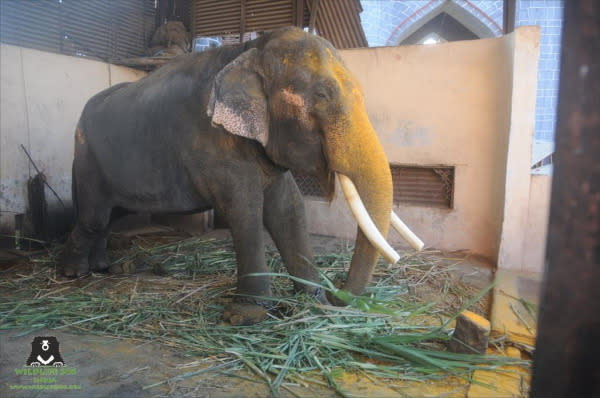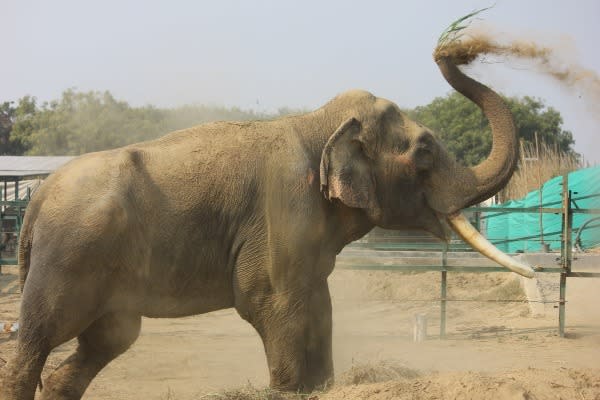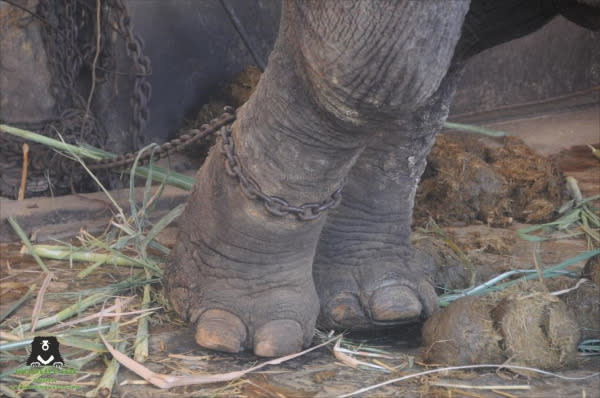Behind “happy” elephant selfies is a lifetime of sadness for the many elephants
Not every Christmas gift fits perfectly into a stocking. Former temple elephant Suraj received a gigantic one last Christmas – a lifetime of freedom.
On Christmas eve, Suraj arrived at WildlifeSOS’s Elephant Conservation and Care Center in Agra, where he will live out the rest of his life, taking long walks, dust baths and hanging out with other rescued elephants.
Before his rescue, life for Suraj, like most other elephants in captivity – was pure hell.
The 45-year old bull elephant had most probably been torn away from his mother and herd, when he was a calf. He was probably tamed through a continuous cycle of violence and punishment, until his spirit was broken and he succumbed to his miserable fate.
Belonging to the Martand Devsthan Trust in Maharashtra, Suraj would be taken out once a year for a parade. But in January 2015, he trampled upon a pedestrian during one such outing. His punishment was solitary confinement in a 20 foot by 20 space with tight spiked chains on all four limbs. He was kept here 24/7, from dawn to dusk. As you can see in this photograph, his chains left him with barely any scope to manoeuvre. Imagine being chained like this for perpetuity!

Even before his spell of solitary confinement, ropes constricted his movements. The video below gives us a glimpse. If you look closely you will realise that Suraj also no left ear (elephants often lose their ears due to brutal training).
Suraj’s Rescue And Rehabilitation
According to WildlifeSOS, when they arrived to rescue Suraj, he was fast asleep. As is the case with most elephant rescues, a crowd gathered, and Suraj, obviously sensing the tension, woke up. He began swaying his trunk at the gathering crowds, but two of the organisation’s elephant keepers were stationed beside him to keep him distracted and ensure that he remained calm.
He was then transported in a special ambulance. In the pic, you have a peek of Suraj’s trunk en route :)

When he arrived at the centre, we was checked thoroughly by the veterinarians, and continues with his medical treatment. Other rescue elephants Raju, Walnut and Macademia, gave him a warm welcome with some loud trumpeting! Now, he goes on long walks in the sun, has access to a pool, enrichments to keep him active and healthy, and lots of nutritious green fodder and natural fruit and vegetable treats. Here are some glimpses of Suraj post rescue…


Suraj has also begun interacting with the other rescued circus elephant Rajesh. His arrival at the center takes the number of rescued elephants at the centre to 18. Here’s Suraj, enjoying some bananas from WildlifeSOS founder Karthik.

The World Of “Working Elephants”
In case you are wondering, Suraj’s case is not unique. According to WildlifeSOS, there are approximately 600 temple elephants in Kerala and 80 to 100 temple elephants in Maharashtra.
Though there are laws in place to prevent illegal captivity of elephants and the mistreatment of elephants in captivity, these are blatantly flouted, and keepers often rely on loopholes and insufficient law enforcement to continue to abuse the animals. This expose by Liz Jones is an eye opener.
There are other types of “working elephants” as well; their occupations range from giving joyrides and bathing human beings with their trunks (while the poor elephant stands chained for hours and the tourist sits on his back) to walking in parades (while bedecked in suffocating attire) and performing dangerous acts at circuses. There have also been instances where baby baby elephants have been paraded at parties, while drunken partygoers take selfies with the terrified little being.
Please understand that all the recreational activities mentioned above scream abuse. Elephant parades, while they look grand, can prove to be quite a torturous experience to these animals. I believe that the best place for elephant parades is in the wild, along with their herds, with their babies right next to them, like in this adorable clip of The Jungle Book :)
Signs That An Elephant Is Being Abused
While the thought of seeing elephants is very exciting, we must make sure that the circumstances that we meet them in is not miserable for the elephant.
If you observe any of these signs during your vacation, it’s pretty obvious that the organisation holding them captive is abusing them in some form:
Poor footcare, due to too much walking and standing on cemented ground. This includes overgrown cracked toenails and cracked footpads. Here is a close-up of Suraj’s feet before the rescue. Observe the chains and the feet, amid the faeces!

Look out for wounds along ankles and feet from spiked chains and restraints, weak limbs and raw elbow joints from being forced to kneel and lie down repeatedly on solid floors.
Watch out for abscesses and wounds from being beaten with a stick or a sharp object like a bullhook.
You may notice torn or pierced ears from frequently tugging at this exceptionally sensitive part of the body, as was the case with Suraj
Elephants in captivity also often suffer from ‘Stereotyping’ – swaying the head from side to side or shifting repeatedly from one foot to the other. This behaviour is caused by severe mental trauma and psychological stress of being held captive.
You can also tell that an elephant is being improperly cared for if it is chained in one place for long hours, particularly in unhygienic environments - improper drainage in the enclosure, standing in its own faeces, urine and old fodder.
Observe whether it is being forced to stand or walk in the sun for long periods of time. Here’s a video of elephants in chains at the Ahmedebad zoo. The poor things can barely move! Is this really how we want to treat our elephants?
There’s A Lot YOU Can Do To Help Elephants.
When you observe signs of abuse, take pictures and videos and post them online, to create awareness.
Refuse to patronise activities or places that are cruel to elephants.
Instead, frequent sanctuaries that promote meaningful engagement with these beautiful mammoths in an unobtrusive way – feeding them, walking alongside with them as opposed to riding them, and of course, bathing them with the supervision of the sanctuary staff. Only these activities are considered kosher under ethical tourism guidelines.
Sanctuaries typically keep rescued animals, while zoos and other elephant hubs source the elephants for the purpose of being displayed for human entertainment. In the odd case, a zoo may have transitioned into a space, where elephants are safe and not abused.
Here’s a video of the Elephant Nature Park in Thailand, which is doing something right.
Closer to home, if you want to see elephants, and really know the true nature of these beautiful souls, instead of going to the circus or riding them, visit WildlifeSOS’ Centre, where you can volunteer, stay and experience the life of an elephant up close.
Here’s what an ele-pool party at the centre looks like! This video features four rescued elephants Asha, Lakhi, Coco and Peanut, having a blast.
Peanut is the youngest elephant at the centre. In April 2015, she was rescued (at age 6) along with three other young elephants (affectionately called the Nut Herd) from the Moonlight circus, where they were subject to extreme abuse. Now, Peanut is a playful little one, full of shenanigans like a baby elephant, should be.
